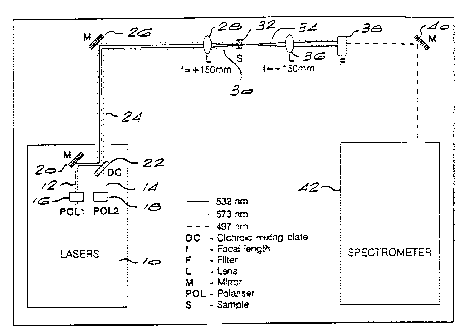Some of the information on this Web page has been provided by external sources. The Government of Canada is not responsible for the accuracy, reliability or currency of the information supplied by external sources. Users wishing to rely upon this information should consult directly with the source of the information. Content provided by external sources is not subject to official languages, privacy and accessibility requirements.
Any discrepancies in the text and image of the Claims and Abstract are due to differing posting times. Text of the Claims and Abstract are posted:
| (12) Patent: | (11) CA 2241470 |
|---|---|
| (54) English Title: | DIAMOND DETECTION USING COHERENT ANTI-STOKES RAMAN SPECTROSCOPY |
| (54) French Title: | DETECTION DES DIAMANTS A L'AIDE DE LA DIFFUSION RAMAN ANTI-STOKES COHERENTE |
| Status: | Expired and beyond the Period of Reversal |
| (51) International Patent Classification (IPC): |
|
|---|---|
| (72) Inventors : |
|
| (73) Owners : |
|
| (71) Applicants : |
|
| (74) Agent: | GOWLING WLG (CANADA) LLP |
| (74) Associate agent: | |
| (45) Issued: | 2005-06-21 |
| (22) Filed Date: | 1998-06-23 |
| (41) Open to Public Inspection: | 1998-12-26 |
| Examination requested: | 2002-08-02 |
| Availability of licence: | N/A |
| Dedicated to the Public: | N/A |
| (25) Language of filing: | English |
| Patent Cooperation Treaty (PCT): | No |
|---|
| (30) Application Priority Data: | ||||||
|---|---|---|---|---|---|---|
|
The invention concerns a method and apparatus for detecting diamonds. In
the method, particles (32) undergoing analysis are irradiated by a beam (30)
of laser light formed by focusing multiple laser beams (12, 14). At least two
of these beams have frequencies differing from one another by a value
characteristic of diamond so that, in the focused beam, at least some
components of the laser beams are coherently phase-matched. The scattered
signal emitted by each particle is then collected and a determination is made
as to whether such signal is a CARS signal characteristic of diamond.
Note: Claims are shown in the official language in which they were submitted.
Note: Descriptions are shown in the official language in which they were submitted.

2024-08-01:As part of the Next Generation Patents (NGP) transition, the Canadian Patents Database (CPD) now contains a more detailed Event History, which replicates the Event Log of our new back-office solution.
Please note that "Inactive:" events refers to events no longer in use in our new back-office solution.
For a clearer understanding of the status of the application/patent presented on this page, the site Disclaimer , as well as the definitions for Patent , Event History , Maintenance Fee and Payment History should be consulted.
| Description | Date |
|---|---|
| Time Limit for Reversal Expired | 2010-06-23 |
| Letter Sent | 2009-06-23 |
| Inactive: IPC from MCD | 2006-03-12 |
| Grant by Issuance | 2005-06-21 |
| Inactive: Cover page published | 2005-06-20 |
| Pre-grant | 2005-04-05 |
| Inactive: Final fee received | 2005-04-05 |
| Letter Sent | 2005-03-10 |
| Notice of Allowance is Issued | 2005-03-10 |
| Notice of Allowance is Issued | 2005-03-10 |
| Inactive: Approved for allowance (AFA) | 2005-02-22 |
| Letter Sent | 2002-09-10 |
| Request for Examination Requirements Determined Compliant | 2002-08-02 |
| Request for Examination Received | 2002-08-02 |
| All Requirements for Examination Determined Compliant | 2002-08-02 |
| Application Published (Open to Public Inspection) | 1998-12-26 |
| Amendment Received - Voluntary Amendment | 1998-12-17 |
| Inactive: Single transfer | 1998-12-17 |
| Inactive: First IPC assigned | 1998-09-24 |
| Inactive: IPC assigned | 1998-09-24 |
| Classification Modified | 1998-09-24 |
| Inactive: IPC assigned | 1998-09-24 |
| Inactive: Courtesy letter - Evidence | 1998-09-08 |
| Inactive: Filing certificate - No RFE (English) | 1998-09-03 |
| Application Received - Regular National | 1998-09-02 |
There is no abandonment history.
The last payment was received on 2005-04-04
Note : If the full payment has not been received on or before the date indicated, a further fee may be required which may be one of the following
Patent fees are adjusted on the 1st of January every year. The amounts above are the current amounts if received by December 31 of the current year.
Please refer to the CIPO
Patent Fees
web page to see all current fee amounts.
| Fee Type | Anniversary Year | Due Date | Paid Date |
|---|---|---|---|
| Registration of a document | 1998-06-23 | ||
| Application fee - standard | 1998-06-23 | ||
| MF (application, 2nd anniv.) - standard | 02 | 2000-06-23 | 2000-05-10 |
| MF (application, 3rd anniv.) - standard | 03 | 2001-06-25 | 2001-03-12 |
| MF (application, 4th anniv.) - standard | 04 | 2002-06-24 | 2002-04-04 |
| Request for examination - standard | 2002-08-02 | ||
| MF (application, 5th anniv.) - standard | 05 | 2003-06-23 | 2003-03-21 |
| MF (application, 6th anniv.) - standard | 06 | 2004-06-23 | 2004-03-31 |
| MF (application, 7th anniv.) - standard | 07 | 2005-06-23 | 2005-04-04 |
| Final fee - standard | 2005-04-05 | ||
| MF (patent, 8th anniv.) - standard | 2006-06-23 | 2006-05-05 | |
| MF (patent, 9th anniv.) - standard | 2007-06-25 | 2007-05-07 | |
| MF (patent, 10th anniv.) - standard | 2008-06-23 | 2008-05-12 |
Note: Records showing the ownership history in alphabetical order.
| Current Owners on Record |
|---|
| DE BEERS CONSOLIDATED MINES LIMITED |
| DE BEERS CONSOLIDATED MINES LIMITED |
| Past Owners on Record |
|---|
| GERALD NOEL VAN DER HORST ROBERTSON |
| HARRY STEPHEN THACKWRAY DRIVER |
| NARENDRA BALAGURU VIRANNA |
| SISA LESLY PITYANA |